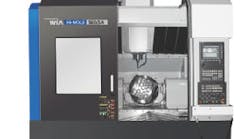Moldmaking is one of the market segments that Hyundai WIA has identified for its business strategy, and has made a considerable investment in recent years to develop systems that produce precision molds. Moldmakers, too, have been investing in new equipment for machining molds; they realize it’s no longer practical to invest in a basic vertical machine center if they expect their products to achieve and maintain global competitive standing. Rather than a standard C-frame VMC accessorized for making molds, they’re adopting bridge-type machines that achieve spindle speeds to 40,000 rpm, offering through-spindle coolant and simultaneous 5-axis capability. That describes Hyundai WIA’s new Hi-Mold Series vertical machine centers, engineered specifically for machining precision molds.
The Hi-Mold’s bridge design offers the high rigidity and low-heat generating characteristics that support precision moldmaking. The head of the main axis moves up and down and left and right on the cross beam. The table in turn moves front to rear. In order to eliminate thermal increase during machining, all axes are driven by high-precision, double-nut ball screws. The double pretension design provides outstanding positioning and repeatability with virtually no thermal increase. All ball screws are connected directly to the servo drive motors without gears or belts, to eliminate backlash. Rapid high-speed axis movement is achieved by the use of linear motion guideways, and this will reduce non-cutting time and decreases machining time. Its spindle traverse for the X/Y/Z axes is 50/50/50 m/min; for the A/C axes, 70/150 rpm.
High-speed main spindle — The main spindle of the Hi-Mold VMC is designed for precision machining at 24,000 rpm, with precision-class angular bearings that provide high-speed acceleration/deceleration. It’s also a quite, low-vibration spindle, even at the highest rotation levels, that Hyundai WIA reported promotes stability by minimizing thermal transmisssion to the main spindle.
The Hi-Mold Series has an optional, 40,000-rpm main spindle for high-quality machining of mold bases and cavities. Spindle temperature can be controlled by using a spindle oil chiller, which ensures constant oil temperature and reduces growth in the spindle due to heat distortion. Through-the-spindle coolant (20, 30, 70 bar) guarantees stable machining, according to the machine developer, and extends tool life by decreasing heat generation caused by high speed machining, in particular with deep-hole machining. The spindle taper is HSK-A63, spindle speed is 24,000 rpm (optional 40,000 rpm), spindle output is 33/25 kW, spindle torque is 96/72.5 Nm, and the spindle drive is built in.
The Hi-Mold Series offers an automatic tool changer and magazine that are separated by a shutter system, which closes during machining to keep chips and fluids clear of the ATC and magazine. When a tool change is required, machining stops, the shutter opens, the ATC exchanges the current tool for a new one, the shutter door closes, and machining begins again.
Hyundai WIA stated its HSK spindle offers users “the fastest possible material removal rates, highest accuracy, and rigidity,” and added that it “guarantees stability” at the high spindle speeds expected for mold manufacturing. The series has a range of 24 tools (30 tools on the Hi-Mold 750/5A.) The maximum tool diameter is 120/140 mm (20 mm at 40,000 rpm.) Maximum tool length is 300 mm (100 mm at 40,000 rpm.) Maximum tool weight is 8 kg (1.5 kg at 40,000 rpm), and the tool change time is rated as 2.6 seconds.
Built-in tilt rotating table — The new series reportedly has a “revolutionary rotating and tilting table design” that permits machining of various complex shapes and mold components. The C-axis rotation is a full 360° at 150 rpm, while the A-axis rotation is 150° at 70 rpm. Each rotational axis is designed with a hydraulic clamping system and roller bearings, resulting in both stiffness and precision. The tilting angle is +30° to -120°. The minimum directive angle is 0.001°. Compared to similar machines, Hyundai WIA said its Hi-Mold series has a larger work area, simplifying setup and use. The maximum table load is 250 kg.
Workpiece coordinate values can be set automatically using the optional spindle probe. Tool lengths and diameters can be set automatically using the optional tool setter, and this can be used to monitor tool wear and detect broken tools. Linear scales can be applied if high-accuracy positioning is required.
Advanced CNC control — The Hi-Mold Series is offered with a choice of CNC controls (Siemens Sinumerik 840D or Fanuc 31i-A), capable of processing high volumes of information quickly, and with increased look-ahead capability: Hyundai WIA quotes the potential for processing 300 blocks of data in advance of execution. To define curves and surfaces, the Series’ CAD/CAM systems employ spline algorithms that result in very long part programs. NURBS enable both freeform curves and conics (straights, circles, ellipses, etc.) to be defined in a uniform manner, taking less time to execute. Feed Forward Function reduces the “path following error” by adjusting gain, accel/decel and feed rate while the machine is running. All these attributes help to optimize spindle speeds, feed rates, accuracy and surface integrity.







